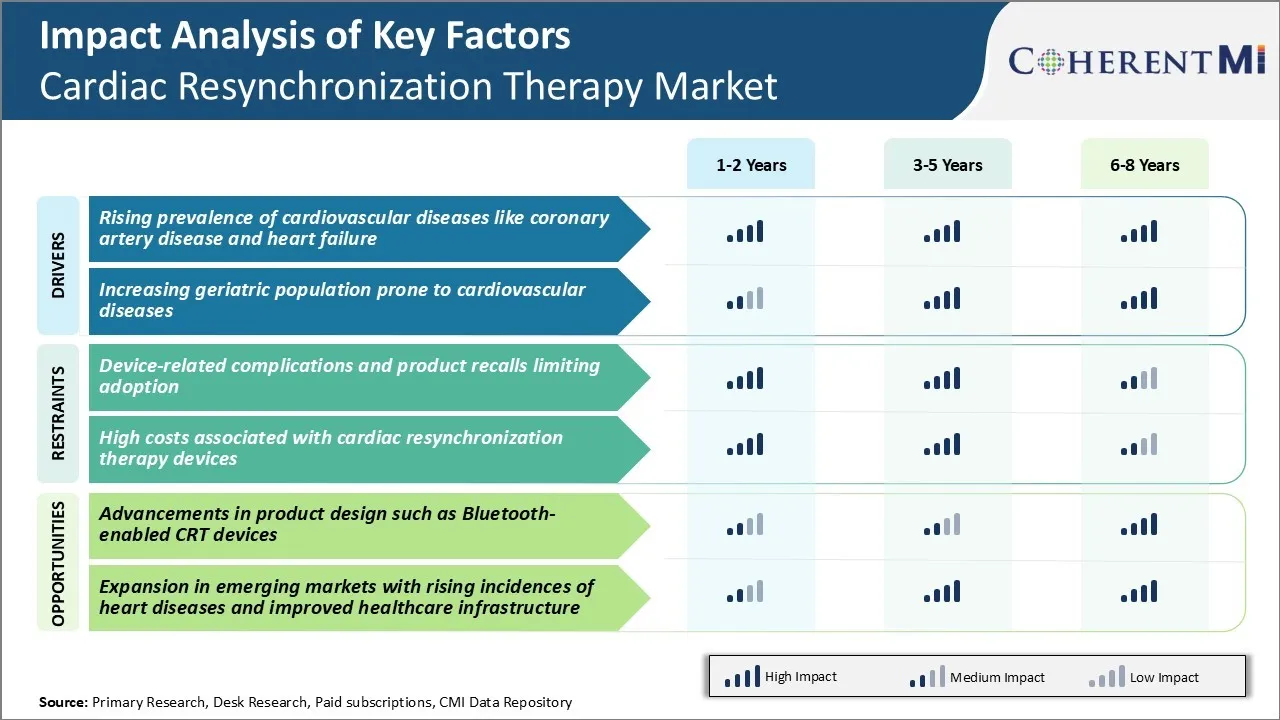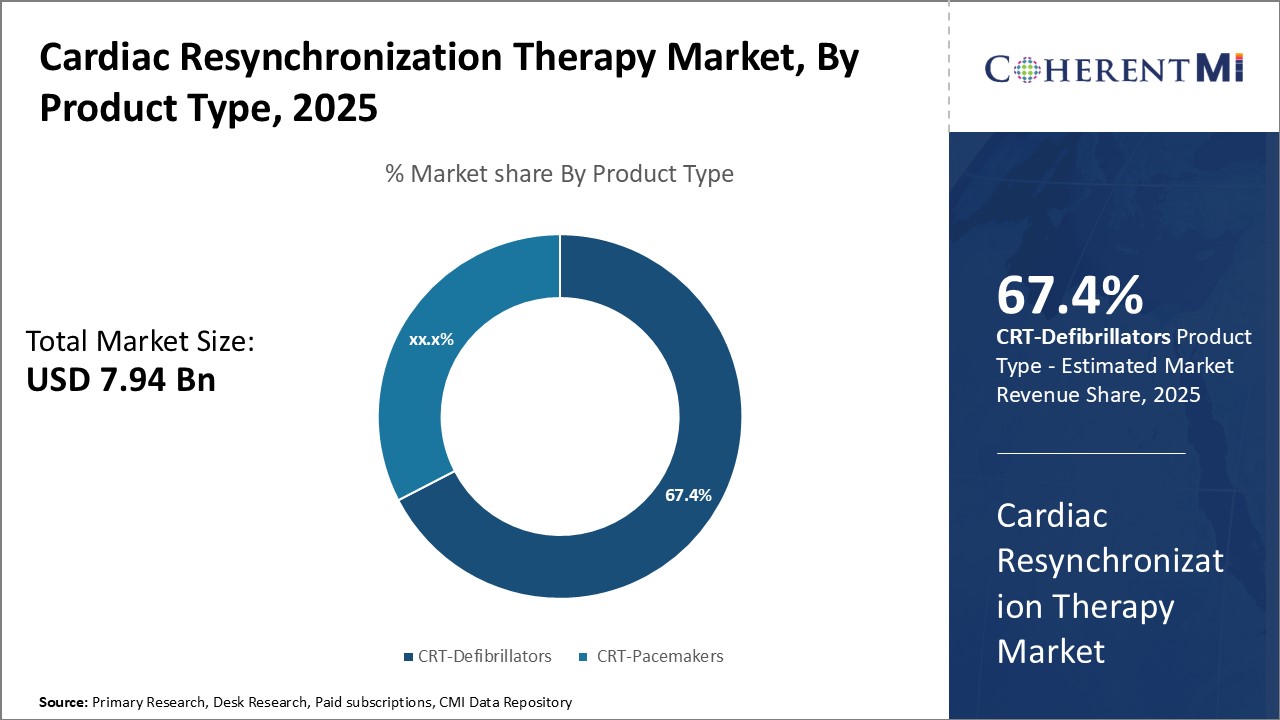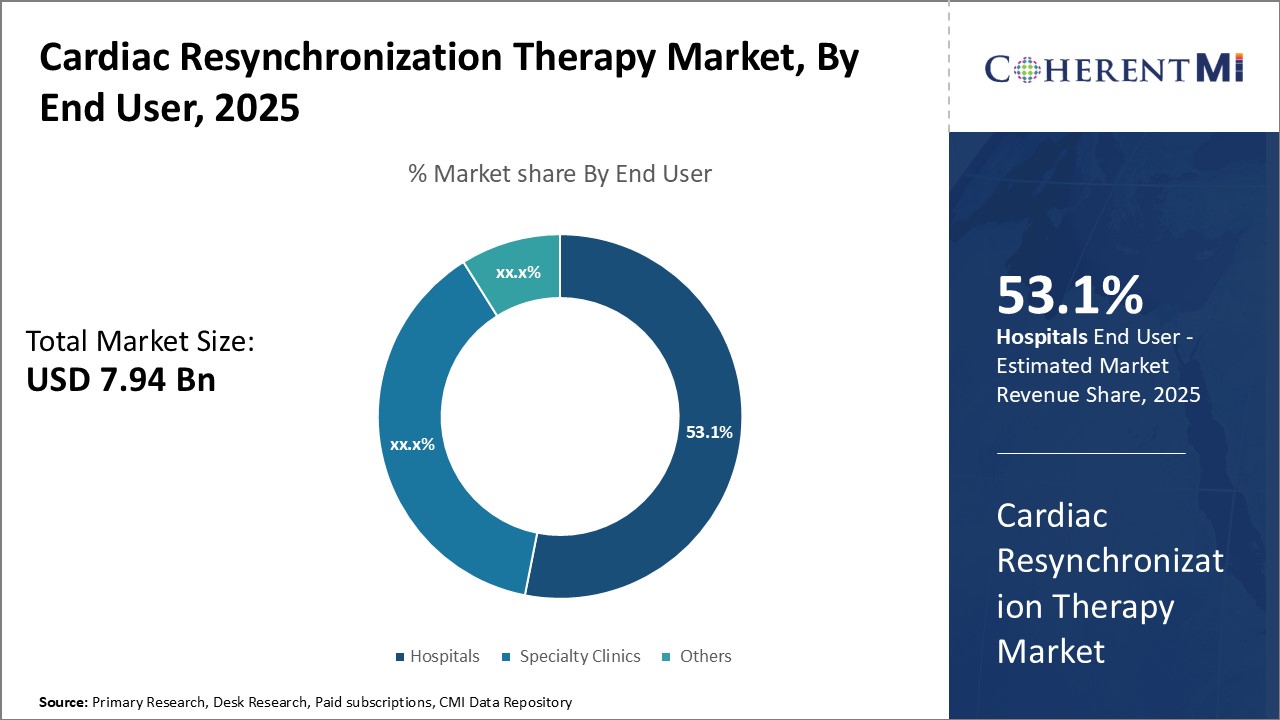Cardiac Resynchronization Therapy Market Size - Analysis
The cardiac resynchronization therapy (CRT) market is estimated to be valued at USD 7.94 billion in 2025 and is expected to reach USD 12.42 billion by 2032, growing at a compound annual growth rate (CAGR) of 6.6% from 2025 to 2032. Advancements in cardiac devices along with the rising geriatric population suffering from chronic heart conditions are major factors driving the growth of this market.
Market Size in USD Bn
CAGR6.6%
| Study Period | 2025-2032 |
| Base Year of Estimation | 2024 |
| CAGR | 6.6% |
| Market Concentration | High |
| Major Players | Medtronic, Abbott, Boston Scientific Corporation, BIOTRONIK, Microport Scientific Corporation and Among Others |
please let us know !
Cardiac Resynchronization Therapy Market Trends
The increasing incidence of cardiovascular diseases such as coronary artery disease and heart failure is a major factor driving the demand for cardiac resynchronization therapy devices. Heart failure has reached epidemic proportions globally due to prolonged life expectancy and improved management of hypertension, myocardial infarction, and other heart conditions. It is estimated that over 64 million people suffer from heart failure worldwide.
Device companies have responded with innovative technological advancements such as contact force sensing leads, automated programming algorithms, and wireless communication capabilities that further augment the benefits of CRT. Greater awareness among physicians and patients alike about the therapeutic potential of this technology for symptomatic heart failure has spurred demand.
Advanced age is a major risk factor for cardiovascular diseases since the chances of developing conditions like coronary artery disease, heart failure, and arrhythmias increase substantially with each passing decade after 60 years of age. Of note, over 50% of heart failure cases occur in individuals aged 70 years and above.
In most countries, the 65+ demographic is the fastest growing segment of the population. This demographic expansion of the geriatric segment is anticipated to fuel the burden of cardiac illnesses in the coming years. Elderly patients also tend to have worsening cardiac function over time necessitating device upgrades. The advanced age-related frailty also means that even mild forms of heart disease severely impact quality of life in older persons. Cardiac resynchronization therapy improves ventricular synchrony and symptoms in this high-risk group, helping them maintain independence longer. Its life enhancing benefits have made it an attractive option for the sizable base of elderly cardiac patients.

One of the major challenges faced in the cardiac resynchronization therapy market has been complications arising from device-related issues and product recalls. CRT devices are known to have risks of lead dislodgment and perforation, which may require surgical intervention for correction.
In recent years, some manufacturers have also issued large-scale recalls of their CRT devices owing to defects detected. Mass product withdrawals erode customer trust in the technology and brand image. It also disrupts the treatment of existing patients who may need replacement devices.
One of the major opportunities in the cardiac resynchronization therapy market lies in advancements in product design. Companies have been investing heavily in research and development to make CRT devices more reliable, safer and user-friendly.
Doctors can track the performance and functioning of implantable systems in real-time. They can detect potential problems early on and resolve any technical glitches remotely via programming. This spares patients unnecessary hospital visits or re-operations.
Key winning strategies adopted by key players of Cardiac Resynchronization Therapy Market
Product Innovation: Developing advanced and innovative CRT devices has helped players gain an edge. In 2018, Medtronic launched its Azure CRT-P pacemaker with AdaptivCRT technology which automatically adjusts left ventricular pacing sites based on daily patient activity levels. This ensured optimal heart synchronization and better outcomes.
Mergers & Acquisitions: Strategic M&A helped bolster product portfolios. In 2020, Boston Scientific acquired Preventice to add mobile cardiac monitoring solutions to its CRT portfolio. This enabled Patient management across the continuum of care. Similarly, Medtronics' acquisition of Covidien in 2015 strengthened its diagnostic and monitoring device offerings along with implantable devices. The integrated product suites drove higher procedure volumes and revenue growth.
Segmental Analysis of Cardiac Resynchronization Therapy Market
 Insights, By Product Type: CRT defibrillators Maintain Highest Market Share Owning to Their Advanced Features
Insights, By Product Type: CRT defibrillators Maintain Highest Market Share Owning to Their Advanced FeaturesThe cardiac resynchronization therapy market is segmented based on product type into CRT defibrillators and CRT pacemakers. CRT defibrillators account for the highest share of this market owing to their advanced features.
This dual-function of CRT defibrillators makes them a preferred choice over CRT-pacemakers for treating heart failure patients who are also at high risk of developing lethal heart rhythms. The advanced monitoring and treatment capabilities offered by CRT defibrillators help improve patient outcomes and quality of life more effectively compared to CRT pacemakers alone. Technological advancements have made CRT defibrillators more reliable and easier to implant as well. These advantages continue to drive the higher adoption of CRT defibrillators over CRT pacemakers.

The cardiac resynchronization therapy market is segmented based on end user into hospitals, specialty clinics, and others. Hospitals account for the highest share of this market owing to their ability to offer better care management to heart failure patients undergoing CRT.
Moreover, complications may occur during or after a CRT procedure that require immediate treatment or hospitalization. Hospitals are best equipped to handle any emergencies and provide intensive post-procedure care. They can closely monitor patients through in-hospital device checks and follow-ups.
Competitive overview of Cardiac Resynchronization Therapy Market
The major players operating in the cardiac resynchronization therapy market include Medtronic, Abbott, Boston Scientific Corporation, BIOTRONIK, EBR Systems, Inc., Microport Scientific Corporation, and MEDICO S.p.A..
Cardiac Resynchronization Therapy Market Leaders
- Medtronic
- Abbott
- Boston Scientific Corporation
- BIOTRONIK
- Microport Scientific Corporation
Cardiac Resynchronization Therapy Market - Competitive Rivalry

Cardiac Resynchronization Therapy Market
(Dominated by major players)
(Highly competitive with lots of players.)
Recent Developments in Cardiac Resynchronization Therapy Market
- In July 2020, Abbott received FDA approval for its next-generation Gallant™ implantable cardioverter defibrillator (ICD) and cardiac resynchronization therapy defibrillator (CRT-D) devices. These devices feature Bluetooth connectivity, which enhances patient monitoring and management through continuous remote monitoring. The devices are compatible with a smartphone app, myMerlinPulse™, which allows for better communication between patients and healthcare providers, helping to manage cardiac arrhythmias and heart failure more effectively.
- In February 2020, Medtronic received CE mark approval for its cardiac resynchronization therapy defibrillators (CRT-Ds), which included advanced features like the AdaptivCRT and EffectivCRT algorithms. These algorithms were designed to improve heart failure treatment by enhancing the synchronization and efficiency of the devices. The AdaptivCRT algorithm helps optimize pacing based on individual patient needs, and the EffectivCRT feature monitors the effectiveness of the pacing in real-time, ensuring better outcomes for patients.
Cardiac Resynchronization Therapy Market Segmentation
- By Product Type
- CRT-Defibrillators
- CRT-Pacemakers
- By End User
- Hospitals
- Specialty Clinics
- Others

Would you like to explore the option of buying individual sections of this report?
Komal Dighe is a Management Consultant with over 8 years of experience in market research and consulting. She excels in managing and delivering high-quality insights and solutions in Health-tech Consulting reports. Her expertise encompasses conducting both primary and secondary research, effectively addressing client requirements, and excelling in market estimation and forecast. Her comprehensive approach ensures that clients receive thorough and accurate analyses, enabling them to make informed decisions and capitalize on market opportunities.
Frequently Asked Questions :
How big is the cardiac resynchronization therapy market?
The cardiac resynchronization therapy (CRT) market is estimated to be valued at USD 7.94 billion in 2025 and is expected to reach USD 12.42 billion by 2032.
What are the key factors hampering the growth of the cardiac resynchronization therapy market?
The device-related complications and product recalls, and high costs associated with cardiac resynchronization therapy devices are the major factors hampering the growth of the cardiac resynchronization therapy market.
What are the major factors driving the cardiac resynchronization therapy market growth?
The rising prevalence of cardiovascular diseases like coronary artery disease and heart failure, and increasing geriatric population prone to cardiovascular diseases are the major factors driving the cardiac resynchronization therapy market.
Which is the leading product type in the cardiac resynchronization therapy market?
The leading product type segment is CRT-defibrillators.
Which are the major players operating in the cardiac resynchronization therapy market?
Medtronic, Abbott, Boston Scientific Corporation, BIOTRONIK, EBR Systems, Inc., Microport Scientific Corporation, and MEDICO S.p.A. are the major players.
What will be the CAGR of the cardiac resynchronization therapy market?
The CAGR of the cardiac resynchronization therapy market is projected to be 6.6% from 2025-2032.